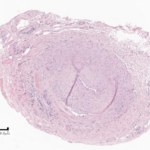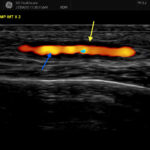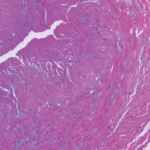In the ACR Convergence 2025 session, Great Debate: Ultrasound vs. Temporal Artery Biopsy in Giant Cell Arteritis, two vasculitis experts went head to head to determine the ideal first test in the diagnosis GCA: ultrasound or biopsy.


Michael Cammarata, MD, RhMSUS |
In the ACR Convergence 2025 session, Great Debate: Ultrasound vs. Temporal Artery Biopsy in Giant Cell Arteritis, two vasculitis experts went head to head to determine the ideal first test in the diagnosis GCA: ultrasound or biopsy.

Philip Seo, MD, MHS |
Summaries of selected research abstracts on the assessment & management of systemic vasculitis from ACR Convergence 2024.

An overview of highlights from the 2025 ECIM meeting, including research on treatment options for systemic sclerosis, the management of PMR & autoimmune testing.

Deborah Levenson |
Results of the international SELECT-GCA study suggest that upadacitinib may be an effective new oral treatment for giant cell arteritis.

Jude Al Qaqaa, MD, Vladimir Falb, DO, & Kaitlyn Buzard, DO |
Giant cell arteritis (GCA), is an inflammatory vasculitis that involves large- and mediumsized arteries, most commonly the cranial branches of the carotid artery.1 It is seen in individuals 50 years and older.1 The most typical manifestation is new-onset headache with scalp tenderness and jaw claudication. 2 The most feared complication associated with GCA is permanent…

Philip Seo, MD, MHS |
The large vessel vasculitides were a major focus of the 21st International Vasculitis Workshop held in Barcelona in April. The biennial conference brings together specialists from multiple disciplines, including rheumatology, nephrology and immunology, to discuss cutting-edge vasculitis research. This article reviews important points regarding the pathogenesis, diagnosis and management of both giant cell arteritis and…

Moayad Alqazlan, MBBS, Vidhya Nair, MBBS, MD, & Michael A. Seidman, MD, PhD |
At the end of 2023, the Society for Cardiovascular Pathology (SCVP) published consensus guidelines on the diagnostic approach to temporal artery biopsy.1 Through this publication, SCVP hopes to bring more uniformity to the processing, interpretation and reporting of these specimens, taking into consideration the most up-to-date literature available. These guidelines have obvious impact on clinical…

Colm Kirby, MB, BCh, BAO, MRCPI, Rachael Flood, MB, BCh, BAO, MRCPI, Ronan Mullan, MB, BCh, BAO, MRCPI, Grainne Murphy, MB, BCh, BAO, MRCPI, & David Kane, MB, BCh, BAO, MRCPI |
Background/Purpose It has been reported that 20–50% of patients with polymyalgia rheumatica (PMR) have subclinical giant cell arteritis (GCA). The natural history of ultrasound-defined subclinical GCA in PMR is not known. Methods Twenty-five newly diagnosed PMR patients who met a clinical diagnosis for PMR, verified by two rheumatologists, were examined by ultrasound. All six branches…

Ashraf Raslan, MD, Dorian Infantino, MD, Roman Zuckerman, DO, & Daniel Berlin, MD |
Giant cell arteritis (GCA) is a granulomatous vasculitis of large- and medium-sized arteries, usually affecting the cranial branches of the aortic arch. It is the most common vasculitis, with the highest risk factor being age. Accurate diagnosis and prompt initiation of therapy are of great importance to prevent serious complications, with the most feared being…

Julia A. Ford, MD, Robert Padera, MD, PhD, & Lindsey A. MacFarlane, MD, MPH |
We report on a 77-year-old patient who was diagnosed with giant cell arteritis (GCA) on histopathology of the submandibular gland and eventually went on to develop classic signs and symptoms of GCA. This observation highlights neck swelling as a rare initial presentation of GCA. Case Presentation A 77-year-old previously healthy man presented to his primary…